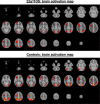Visuospatial working memory in children and adolescents with 22q11.2 deletion syndrome; an fMRI study
- PMID: 21547621
- PMCID: PMC3164011
- DOI: 10.1007/s11689-009-9008-9
Visuospatial working memory in children and adolescents with 22q11.2 deletion syndrome; an fMRI study
Abstract
22q11.2 deletion syndrome (22q11DS) is a genetic disorder associated with a microdeletion of chromosome 22q11. In addition to high rates of neuropsychiatric disorders such as schizophrenia and attention deficit hyperactivity disorder, children with 22q11DS have a specific neuropsychological profile with particular deficits in visuospatial and working memory. However, the neurobiological substrate underlying these deficits is poorly understood. We investigated brain function during a visuospatial working memory (SWM) task in eight children with 22q11DS and 13 healthy controls, using fMRI. Both groups showed task-related activation in dorsolateral prefrontal cortex (DLPFC) and bilateral parietal association cortices. Controls activated parietal and occipital regions significantly more than those with 22q11DS but there was no significant between-group difference in DLPFC. In addition, while controls had a significant age-related increase in the activation of posterior brain regions and an age-related decrease in anterior regions, the 22q11DS children showed the opposite pattern. Genetically determined differences in the development of specific brain systems may underpin the cognitive deficits in 22q11DS, and may contribute to the later development of neuropsychiatric disorders.
Figures





References
-
- Gothelf D, Frisch A, Munitz H, Rockah R, Laufer N, Mozes T, Hermesh H, Weizman A, Frydman M, Gothelf D, Frisch A, Munitz H, Rockah R, Laufer N, Mozes T, Hermesh H, Weizman A, Frydman M. Clinical characteristics of schizophrenia associated with velo-cardio-facial syndrome. Schizophr Res. 1999;35:105–112. doi: 10.1016/S0920-9964(98)00114-5. - DOI - PubMed
-
- Shprintzen RJ, Goldberg RB, Lewin ML, Sidoti EJ, Berkman MD, Argamaso RV, Young D. A new syndrome involving cleft palate, cardiac anomalies typical facies and learning disabilities: velo-cardio-facial syndrome. Cleft Palate J. 1978;15:15–62. - PubMed
-
- Papolos DF, Faedda GL, Veit S, Goldberg R, Morrow B, Kucherlapati R, Shprintzen RJ, Papolos DF, Faedda GL, Veit S, Goldberg R, Morrow B, Kucherlapati R, Shprintzen RJ. Bipolar spectrum disorders in patients diagnosed with velo-cardio-facial syndrome: does a hemizygous deletion of chromosome 22q11 result in bipolar affective disorder? Am J Psychiatr. 1996;153:1541–1547. - PubMed
LinkOut - more resources
Full Text Sources
